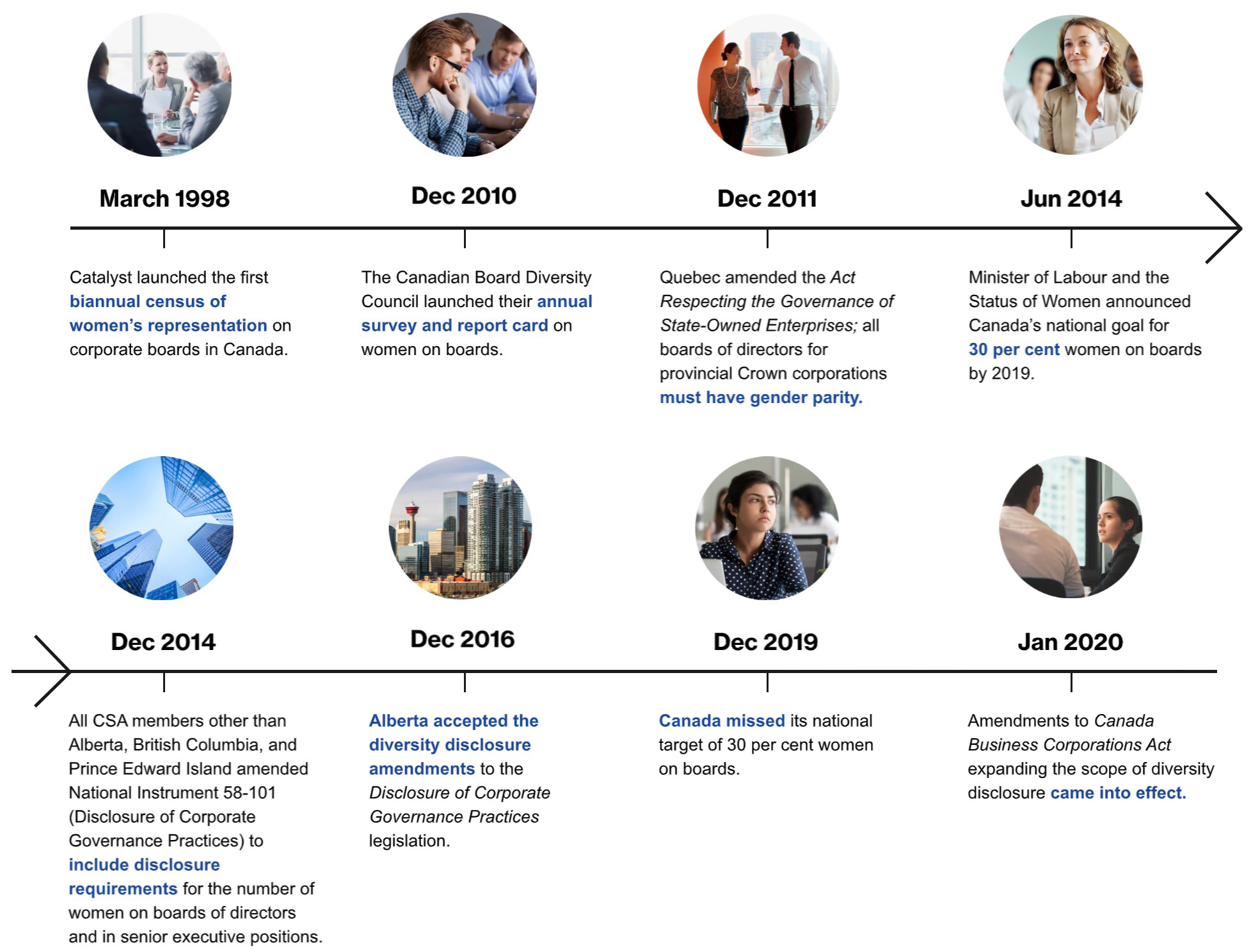
All on Board
Turning Evidence Into Action for Women’s Leadership
The challenge
More women hold senior leadership positions in Canada now than ever before—but progress has been slow.

Equitable, inclusive, and diverse leadership is not only good for business, it’s also the right thing to do. But the lack of women and members of other equity groups in senior leadership positions suggests we are failing to foster diverse and inclusive environments in Canadian workplaces.
Although there has been an increase in equity, diversity, and inclusion policies and practices across Canadian organizations in the last few decades, we don’t always have strong evidence for what works to improve workplace inclusion and what doesn’t.
When it comes to leadership gaps, Canadian decision-makers have zeroed in on the need to increase women’s representation on corporate boards. But we didn’t hit our national target of 30 per cent women on boards by 2019.1 And although yearly reports on changes in women’s representation are available,2 we still know very little about the “how” behind women’s diversity advancements. What are the factors that truly move the dial toward greater representation?
Canada has taken a legislative approach to increasing women’s representation.
In December 2014, the Canadian Securities Administrators (CSA, an umbrella organization of Canada’s provincial and territorial securities regulators that works with them to improve and harmonize market regulation) implemented “comply or explain” disclosure requirements for women’s representation on corporate boards.

A word on disclosure requirements
As of December 31, 2014, all TSX non-venture companies in participating jurisdictions —the largest and most resource-rich companies in Canada—are required to comply with diversity disclosure requirements. What does this mean? All companies have to report annually on information like the proportion of women on their boards or in executive leadership positions, and what efforts the company has made (e.g., diversity policies and/or targets) to increase representation. If they don’t comply, they must explain why.3
What is the purpose? Comply or explain disclosures require public transparency about what companies are doing—or not doing—to increase women’s representation on boards. This transparency is meant to act as a form of public accountability and motivate action on diversity.
All provinces and territories except for British Columbia and Prince Edward Island voluntarily adopted the 2014 disclosure requirements (though Alberta only did so in 2016). Quebec has its own additional mandate for women’s representation that requires 50 per cent representation of women on the boards of Crown corporations.
Source: Canadian Securities Administrators.
Representation among all TSX companies covered by comply or explain still sits at about 18 per cent, meaning many companies have yet to come close to the 30 per cent target.4 But progress has been made by the largest companies. The top 60 TSX companies have achieved 30 per cent women’s representation on boards while the top 250 are at about 27 per cent.5 To what extent have disclosure requirements contributed to increasing levels of women’s representation on boards? Are different approaches needed?
The Conference Board of Canada will evaluate whether Canada’s disclosure requirements have meaningfully increased women’s representation boards, and
how the Canadian context compares with similar international efforts.
Primarily we ask: Do disclosure requirements increase women’s representation on boards, and what other factors matter?

Why should we care?
Board seats are some of the most influential positions in the corporate world.
Women, racialized peoples, and other equity groups are historically under-represented in board seats.6 Women’s representation in leadership is one important step to more diverse representation and inclusive workplaces at all levels and for all Canadians. In fact, recent Canadian legislation now focuses on the need to go beyond women’s representation on boards.7

Expanding the scope of disclosure in Canada
Bill C-25 amends the Canada Business Corporations Act8 to expand the scope of diversity disclosure requirements in Canada. As of January 2020, all Canadian corporations covered by the Act, including venture and non-venture TSX companies,9 are required to report on what they’re doing to increase board representation of all equity groups under the federal Employment Equity Act 10—women, Indigenous Peoples, persons with disabilities, and racialized peoples.
Canada is the first country to focus on board representation beyond women. This is critical given historical leadership inequities faced by groups other than, or that intersect with, women. Canada is expected to be both a test case and a world leader in policy of this kind.
As leaders, it’s more important than ever to understand whether and how disclosure requirements affect representation of historically underrepresented groups—starting with women.
Key moments for women on boards in Canada

Not knowing whether disclosure requirements are effective for women’s representation means we don’t know what works best to:
- help us move the dial on diverse and inclusive representation
- provide meaningful social change for women in corporate Canada
- leverage the benefits of diversity for the economic success of Canadian organizations
Our study of comply or explain disclosure requirements will increase our understanding of Canada’s equity, diversity, and inclusion efforts and their potential impacts.
What will The Conference Board of Canada do?

Through our research, we will use advanced analysis methods to address the following research questions:
- Does disclosure matter for women’s representation?
- Which components of disclosure matter more than others over time (e.g., representation targets, workplace policies)?
- How do organizational (e.g., size, industry, board vacancies) and financial (e.g., market capitalization, shareholder value) characteristics affect the role disclosure requirements play?
Our project will also summarize the successes and challenges of peer countries. We will consider how effective different strategies to increase women’s representation have been and whether a focus on disclosure requirements is enough. Understanding international approaches and debate can help us better frame the Canadian conversation.
Our approach allows us to anchor conversations, policies, and practices in evidence that can, in turn, inform change. And while our research focuses specifically on the number of women on boards in Canada, this research is an important piece of a larger effort to establish empirical insights that can inform policies to improve representation across equity groups.
What’s next?
As our project progresses, stay tuned here for ongoing updates and research products.
Thanks to our project sponsors:
KPMG in Canada—Champion Funder
S&P Global Market Intelligence—In-kind support

- In 2014, when the 2019 target was set by Status of Women Canada, women’s representation on boards across Canada sat at about 10 per cent. Status of Women Canada, “Increasing the Representation of Women on Canadian Boards,” last modified November 28, 2016, accessed December 18, 2019, https://cfc-swc.gc.ca/abu-ans/wwad-cqnf/wldp/wb-ca/rep-rap-en.html; Melissa Bennardo, “Women Hold Less Than 20% of Positions on Corporate Boards, StatsCan Finds,” CBC News, May 7, 2019, accessed December 20, 2019, https://www.cbc.ca/news/business/statistics-canada-women-corporate-boards-1.5125995.
- Examples include Catalyst, Gender Diversity on Boards in Canada: Recommendations for Accelerating Progress (Toronto: Government of Ontario, 2016); Andrew MacDougall and others, 2019 Diversity Disclosure Practices: Women in Leadership Roles at TSX-Listed Companies (Toronto: Osler, Hoskin, and Harcourt LLP, September 18, 2019); Canadian Securities Administrators, CSA Multilateral Staff Notice 58-311: Report on Fifth Staff Review of Disclosure Regarding Women on Boards and in Executive Officer Positions (Montréal, CSA, October 2, 2019), accessed December 20, 2019, https://www.osc.gov.on.ca/documents/en/Securities-Category5/sn_20191002_58-311_staff-review-women-on-boards.pdf; Canadian Board Diversity Council, CBDC Annual Report Card: Advancing Diversity Leadership on Canada’s Corporate Boards (Toronto: CBDC, 2018), accessed December 20, 2019, https://phasenyne.com/wp-content/uploads/2019/03/ARC-Annual-Report-Card-2018.pdf.
- Women’s Executive Network and Canadian Board Diversity Council, “Annual Report Card 2018: Advancing Diverse Leadership on Canada’s Corporate Boards,” 2018, accessed December 20, 2019.
- Canadian Securities Administrators, CSA Multilateral Staff Notice 58-311: Report on Fifth Staff Review of Disclosure Regarding Women on Boards and in Executive Officer Positions (Montréal, CSA, October 2, 2019), accessed December 20, 2019, https://www.osc.gov.on.ca/documents/en/Securities-Category5/sn_20191002_58-311_staff-review-women-on-boards.pdf. Similarly, the most recent report on the Corporations Return Act by Statistics Canada indicated that representation of women on all boards of public, private, and government businesses across Canada sat at about 19 per cent in 2016. Statistics Canada, “Study: Representation of Women on Boards of Directors, 2016,” The Daily, May 7, 2019, Statistics Canada Catalogue no. 11-001-X, accessed January 14, 2020, https://www150.statcan.gc.ca/n1/en/daily-quotidien/190507/dq190507a-eng.pdf?st=Yapbg-7z.
- Canadian Securities Administrators, “Form 58-1101F1: Corporate Governance Disclosure,” December 31, 2016, accessed December 20, 2019, https://www.bcsc.bc.ca/Securities_Law/Policies/Policy5/PDF/58-101F1__F___December_31__2016/.
- We acknowledge that our current legislation is still limited in recognizing diverse genders, other equity groups such as LGBTQ2S+, and the intersectionality of identities. Our analyses are limited by the available reporting data, though we strive to build the methodological foundations that will allow us to understand the impacts of future diversity efforts with more inclusive targets.
- Diversity Institute, Brief Concerning Bill C-25, Canada Business Corporations Act (Toronto: Diversity Institute, n.d.), accessed December 18, 2019, https://sencanada.ca/content/sen/committee/421/BANC/Briefs/BANC_RyersonDIBrief_e.pdf.
- Canada Business Corporations Act, RSC 1985, ch. C-44.
- An Act to Amend the Canada Business Corporations Act, the Canada Cooperatives Act, the Canada Not-for-Profit Corporations Act, and the Competition Act, 2018 S.C., ch. 8.
- Employment Equity Act, 1995 S.C., ch. 44.
To cite this document: Giammarco, Maria, and Kevin O’Meara. “All on Board: Turning Evidence Into Action for Women’s Leadership.” The Conference Board of Canada. January 2020.

